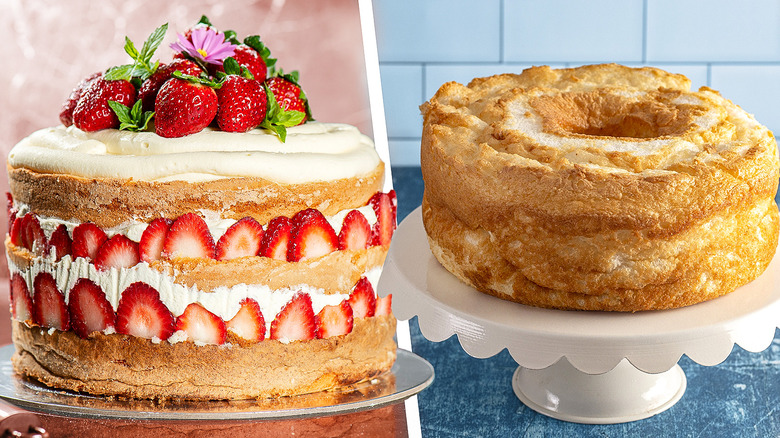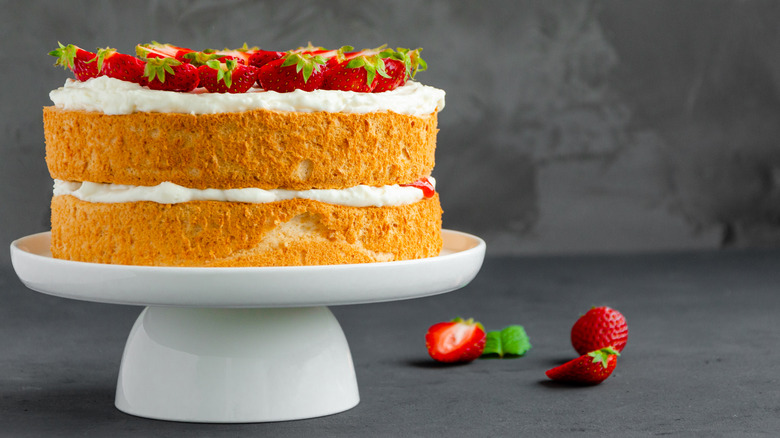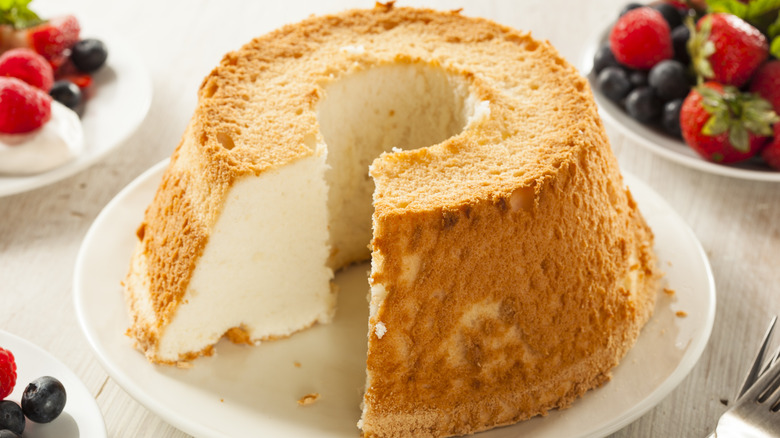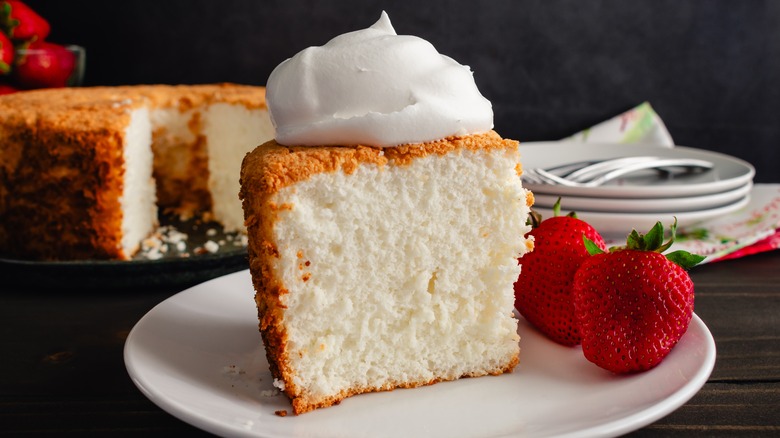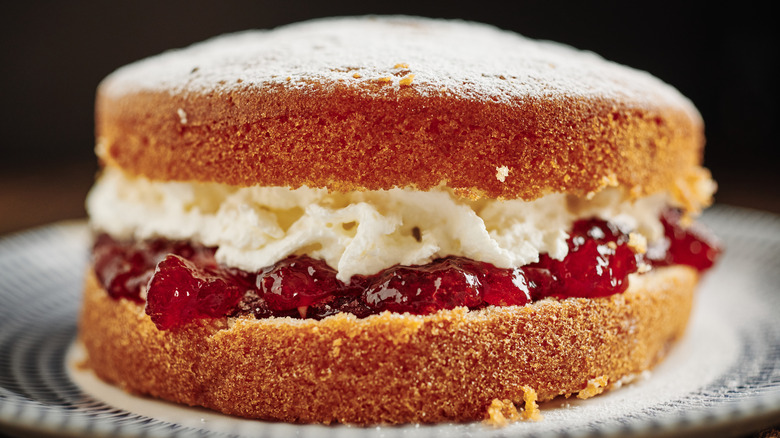Victoria Sponge Vs Angel Food Cake: Is There A Difference?
It's hard to find a dessert more beloved and versatile than cake. With many different types of cake found around the world, each country seems to have its own spin on this pillowy confection. Sponge cake, in particular, is a favorite that has been around since the Renaissance era. Two of the most iconic variations of sponge cake are Victoria sponge and angel food cake. Both of these cakes were born in the 19th century, albeit on different sides of the Atlantic Ocean — Victoria sponge is recognizably British, while angel food cake is North American.
Although both cakes are made with just a few very simple ingredients, there are key differences that ultimately affect the final crumb and flavor, yielding two unique cakes. Victoria sponge is made with whole eggs, while angel food cake only calls for the whites. As a result, one of the cakes is delicate and airy while the other is sturdier and can handle fillings. Both cakes can grace the table for important occasions, but only one of them is considered a teatime snack. Let's dive deeper into how the two cakes are traditionally made and uncover what makes them different.
What is Victoria sponge cake?
Victoria sponge, or Victoria sandwich cake, is one of the most quintessential British desserts. Named after Queen Victoria, who reigned from 1837 to 1901, the cake features strawberry jam and whipped cream sandwiched between two soft sponge cake layers, lightly dusted with powdered sugar on top. Victoria sponge is closely tied to British afternoon tea, a tradition also born during Queen Victoria's reign as a way to tide over the long hours between lunch and dinner with a sweet pick-me-up. Because the Queen had a very sweet tooth, confections were served on the regular, and among Her Majesty's favorites was the cake we know today as Victoria sponge.
The layers of the cake are made with butter, sugar, eggs, flour, and baking powder. The butter is creamed and mixed with sugar until it reaches a fluffy texture. Whole eggs are added next — the addition of the yolks provides color and extra fat alongside the butter, creating a richer flavor. Then, flour and baking powder are added to the batter, though many Brits use self-rising flour that's already mixed with baking powder; the latter gives the cake a beautiful rise, which results in a spongy texture.
Once the cake layers are baked, tradition dictates they should be filled with strawberry jam and whipped cream. The combination of these two fillings is somewhat of a novelty, as Queen Victoria ate her cake only with jam.
What is angel food cake?
Americans will recognize angel food cake as the light, starkly white cake that's baked in a tube pan and served as dessert at large gatherings. It most likely hails from Pennsylvania, where it was dreamt up during the Industrial Revolution as a way to deal with egg whites that were left over from the production of foods that only called for yolks. Creating a cake that only needed the whites was a clever way to use them up and avoid needless waste. According to some historians, the very first people who baked these cakes were enslaved African Americans; angel food cake remains a notable part of Black culture to this day, often being served at funerals.
In contrast with Victoria sponge, angel food cake doesn't call for butter or any other type of fat. It's made by whipping the egg whites with sugar to essentially create a French meringue with stiff peaks. Cream of tartar can be added for more stability. The flour is then sifted and gently folded into the meringue, with the entire process focusing on preserving the delicate texture of this cake. The lack of egg yolks leaves the cake with a pale white color, while the absence of fat keeps it light on the stomach. The cake is baked in a tube pan that's neither greased nor non-stick — after it's baked, angel food cake is famously cooled upside down, so it's important that it sticks to the pan.
Angel food cake is more delicate than Victoria sponge
The difference in ingredients between the two cakes yields a notable difference in texture. Victoria sponge, made with whole eggs and baking powder, has a denser crumb and is more stable overall. You can cut the sponge layers horizontally, stack them on top of each other into several layers, and fill the in-between spaces with a whole variety of fillings. Its stronger texture gives you more room for experimentation.
Angel food cake, in contrast, is very delicate. It has a fluffy, airy texture that makes it somewhat of a challenge to cut into slices, unless you're using a cake breaker — an antique tool that doesn't smush delicate cakes. It's best to eat angel food cake on the same day you make it because it won't retain moisture for long. This cake doesn't contain any fat, so it's quick to dry out. One of the ways to properly store angel food cake is to wrap it tightly with plastic wrap and store it in the fridge, so prolonging its shelf life. In comparison, the layers of Victoria sponge could last a couple of days, but the addition of perishable fillings calls for refrigeration, too.
Angel food cake has toppings while Victoria sponge has fillings
Both cakes have some room for customization and the addition of extra flavors. For angel food cake, those primarily come through toppings — syrups, glazes, fresh fruit, and occasionally whipped cream. Because of its delicate structure, you shouldn't use anything too heavy or moist. Finishing this cake with vanilla or chocolate glaze is popular, as long as you use it sparingly; too much moisture can ruin the cake's quintessential airiness. The safest and easiest way to add freshness (and color) to this light cake is to serve it with fresh berries and a light drizzle of sweet syrup over the cut slices.
While toppings are optional for angel food cake, fillings are a necessity for Victoria sponge; they are the absolute centerpiece of the dessert, and the cake is never enjoyed without them. First, you can swap the strawberry jam for any jam your heart desires. As a step further, you could even skip jam entirely and use fruit compote instead. Another version of skipping the jam includes swapping it for Nutella, which is actually the sweet substitution Queen Camilla goes for.
For the cream, a classic buttercream will bring a more intense and creamy flavor than fluffy whipped cream, but clotted cream and mascarpone are also daring options. Last but not least, fresh fruit is always a good addition to this Royalty-inspired cake, both as a filling and as a topping.
